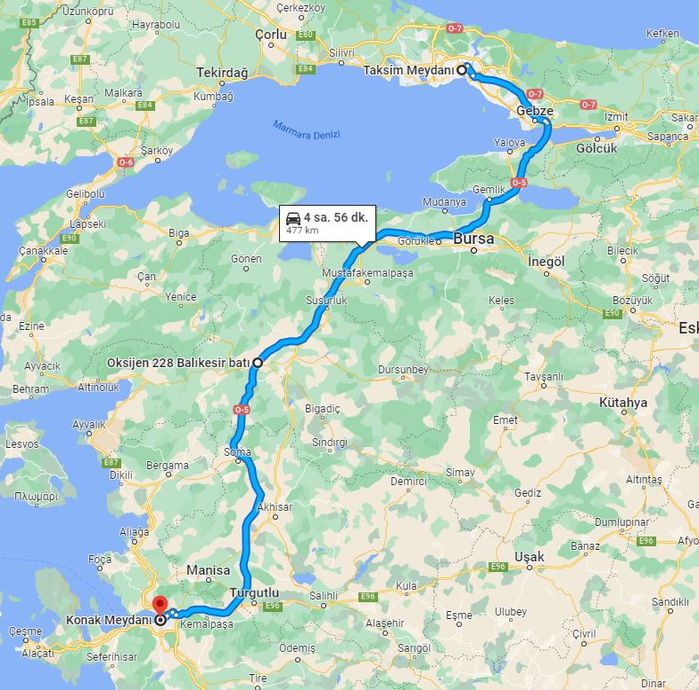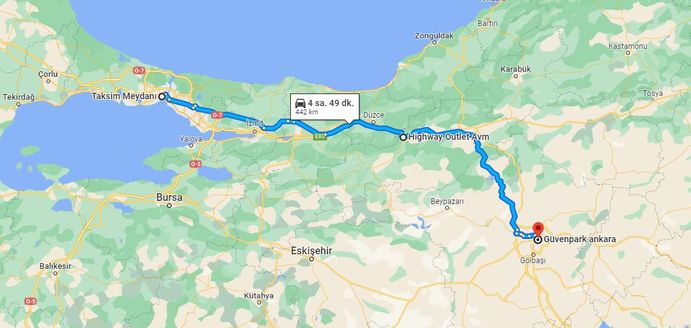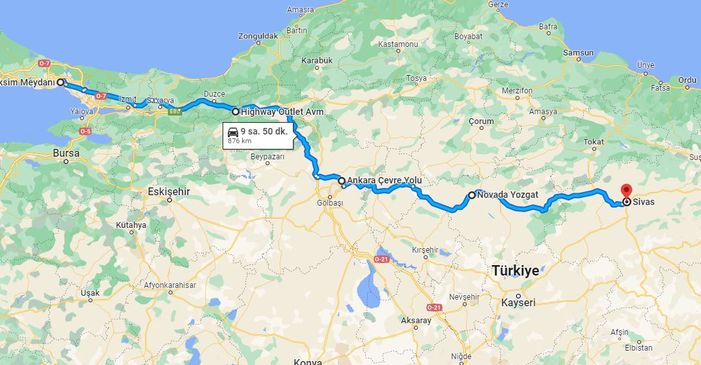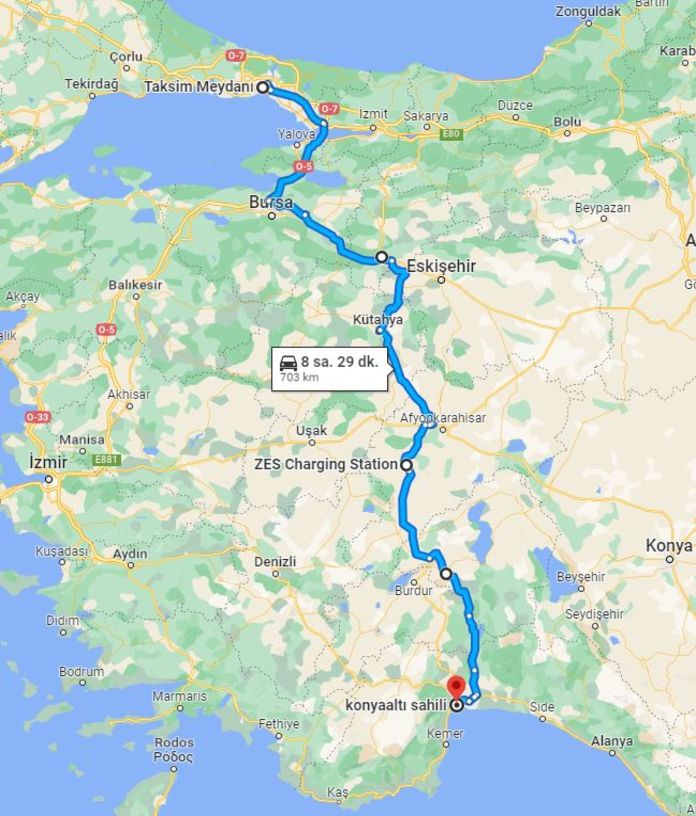Today, in our special dossier we created to answer all questions about electric cars, we examine how far these vehicles can go on a full battery and how many hours of cross-country driving they can do.
In our series of articles, which we have been continuing since the beginning of the week, we have looked at EV charging costs and charging times by one of the best-selling electric cars in Turkey.
This car, which is in the 10 percent SCT segment and is therefore one of the cheapest models of its competitors, has a battery capacity of 39.2 kWh and can drive 305 kilometers with a fully charged battery.
While this range figure is sufficient for everyday city use, it can result in a loss of time compared to the distance traveled on interurban roads.
ISTANBUL-IZMIR 6 HOURS
To explain this situation using different examples: A user who takes Istanbul’s Taksim Square as a starting point with this car, for example, wants to go to Izmir Konak Square and has to cover 477 kilometers as quickly as possible.
This vehicle, which requires charging at least once on this route, can cross the Osmangazi Bridge and travel 275 kilometers via the Istanbul-Izmir Highway and reach the charging station in Balikesir on the Istanbul-Izmir Highway in a total of 3 hours.
Here, with the DC 50kW fast charger, it is possible to charge this car’s battery, which is just under 10 percent, to 80 percent in about 1 hour if there is no queue. After this process, the remaining 200 kilometers to Konak Square from Izmir can be reached in 2 hours.
In conclusion, it is possible to travel between Istanbul and Izmir in 6 hours with this electric vehicle if not expected during charging.
If you want to go to Çeşme, the popular holiday resort of İzmir, the charging process in Balıkesir is not enough, it takes 77 kilometers longer. Because the 80 percent full battery gave the vehicle a range of 240 kilometers.
Assuming that we charge the battery again in İzmir with DC 50 kW fast charging, this time around 30 percent will be required instead of 80 percent, which is sufficient for Cesme with a range of 80 kilometers. After reaching 30 percent of the battery with an average charging time of 20 minutes in İzmir, one can go to Çeşme without being on the road.
In other words, it will be possible to travel between Istanbul and Çeşme in 7 hours and 50 minutes by making only two charging breaks with this car.
ISTANBUL-ANKARA 5 HOURS 20 MINUTES
In order to understand what the range values of electric cars say in everyday life, it makes sense to do this example for other cities as well.
Let’s assume that this time we want to drive the same electric car from Istanbul’s Taksim Square to Güvenpark in the capital Ankara.
If we start the 440-kilometer road with a fully charged battery, the charging station at the parking lot of a shopping center in Bolu is easily accessible after a 240-kilometer drive on the Anatolian Highway, which takes 2 hours and 40 minutes.
Here, after charging the battery at 20 percent charge rate to 60 percent in 30 minutes with DC fast charging, the battery is still more than 10 percent charged after continuously covering the 200-kilometer road to Ankara in 2 hours and 10 minutes. . .
As you can see, it is possible to travel between Istanbul and Ankara in 5 hours and 20 minutes with an electric vehicle with a battery capacity of 39.2 kWh, with a charging break on the way.
ISTANBUL SIVAS APPROX. 12 HOURS
According to Turkish Statistical Institute (TUIK) data, Sivas is the province with the highest number of people registered in Istanbul apart from Istanbul residents. From here, it also makes sense to check how many hours it takes to travel from Istanbul to Sivas in an electric vehicle.
The part of the 876-kilometer road from Istanbul through Sivas city center to Ankara is similar to that described above. Therefore, we can proceed on the Ankara-Sivas road based on the example of Istanbul-Ankara electric car journey that we have studied.
While driving from Istanbul to Ankara by electric vehicle, we mentioned that the vehicle’s battery was 10 percent full upon arrival in Ankara. If the battery in Ankara is 80 percent full in 50 minutes, the remaining 430 kilometers can go to Sivas.
Considering that the vehicle battery has a range of 240 kilometers with an 80 percent charge, this journey requires a charging break at a shopping center in Yozgat on the 206th kilometer of the Ankara-Sivas road.
After this 2-hour drive, the battery needs to be charged to at least 80 percent in Yozgat, as the battery drops to 10 percent and the remaining distance is 223 kilometers. After this process, which takes about 50 minutes, the remaining 223 kilometers to Sivas can be covered in 2 hours and 40 minutes without interruption.
In other words, it is possible to reach the center of Sivas from Istanbul in 11 hours and 40 minutes with a total of 3 charging stations.
ISTANBUL-ANTALYA 10 HOURS 30 MINUTES
To give an example of Antalya, the tourism capital of Turkey, it is possible to reach Kütahya by leaving Istanbul’s Taksim Square with a full battery, crossing the Osmangazi Bridge and taking the 248-kilometer road in 2 hours and 50 minutes Minutes crossed at a constant speed.
Here, if the battery capacity of the vehicle is around 15 percent, if you charge the battery to 80 percent in 45 minutes with DC fast charging and head towards Antalya, after 2 hours and 30 minutes after 210 kilometers a 10 percent full battery will be on returned to the charging station in Afyonkarahisar Sandıklı
After charging the vehicle to 80 percent for 50 minutes, the distance to Antalya Konyaaltı Beach is 235 kilometers. If it were risky to drive this distance with an 80 percent full battery, it would make sense to take another charging break in Isparta after 1 hour and 20 minutes at km 112 of the road.
After charging the 40 percent full battery to 80 percent in 30 minutes, the remaining 135 kilometers to Antalya can be covered in around 2 hours.
As a result, a total of 705 kilometers journey from Istanbul’s Taksim Square to Antalya’s Konyaaltı Beach can be covered in 10 hours and 30 minutes with 3 charging stops by electric car.
CHARGING IS FAST AS SPEED
In all of these examples, care must be taken to ensure that an average speed of 100 kilometers per hour is not exceeded while driving.
If this limit is exceeded, which is the optimal speed value for an electric car, more charging breaks have to be taken between cities due to the increasing power consumption.
Therefore, contrary to popular belief, completing high-speed kilometers in less time does not save time.
You should also know that when building the same roads with an electric car with a higher battery capacity than the car in our test report, both the charging times and the range values will change.
Before you embark on a longer journey with an electric car, it makes sense to take a look at the map of the subscribed station network so that you don’t stay on the road.
10 PERCENT IN EUROPE, 1 PERCENT IN TURKEY
When it comes to electric vehicles, Turkey has not yet caught up with Europe in terms of sales figures and production volume.
From January to August, only 3,283 of the 458,000 cars sold in Turkey were electric vehicles. Although EV sales have tripled compared to the same period last year, these cars still account for less than 1 percent of the market.
In Europe, the largest export market of the Turkish automotive industry and where cars sold in Turkey are subject to registration, 100% electric cars have a market share of 10 percent.
The resulting table shows that Turkish users, compared to European users, keep their distance from EVs for various reasons.
Judging from the research, the first issue that raises concerns about electric vehicles among consumers in Turkey is the charging infrastructure. According to Castrol research, 70 percent of non-EV drivers believe charging infrastructure is not widespread enough.
The lack of electric model options on the market and the lack of government incentives are among the main reasons for the cautious focus on electric cars, according to the study.
According to the same report, 49 percent of consumers in Turkey who took part in the survey would like their next vehicle to be electric.
The fact that Turkey is ahead of France, Australia, New Zealand, the USA, India and Germany in this ratio shows that electric car sales can increase significantly if conditions match consumer expectations.
If you consider that there are only a few days left until the domestic car hits the assembly lines, you can say that the legislator and the Turkish automotive/supply industry do not have much time left to take serious steps towards electric vehicles.
Otherwise, the Turkish market could risk falling behind Europe, which has started to “electrify”. Such a situation could put Togg’s future in trouble.
As a final footnote, the number of EV charging stations, which totaled 3,500 in March, rose to 11,000 in September, including public and private use, according to data from the Turkish Electric and Hybrid Vehicle Association (TEHAD). Considering that around 7,000 electric vehicles are on Turkey’s roads and sales of these vehicles have tripled in the last year, it becomes clear that a rapid increase in the number of charging stations is needed.
#long #road




No comments:
Post a Comment